Evaluation of Water Social Service and Comprehensive Water Management Linked with Integrated River Evaluation
Abstract
1. Introduction
2. Materials
2.1. Study Area
2.2. Data Collection
3. Methodology
3.1. Indicator Selection for Water Social Service Evaluation
3.2. Building Indicator’s Data
3.3. Normality and Standardization of Each Indicator’s Data
3.4. Indicator Selection and Reliability Review
3.5. Index Equation Design and Weighted Value Calculation for Evaluating Water Social Service
3.5.1. Index Equation Design for Evaluating Water Social Service
3.5.2. Calculating the Weighted Value
Calculation of Weighted Value Using Principal Component Analysis Method
Calculation of Weighted Value Using Entropy Weighted Methods
3.6. Assigning Ratings to Water Social Service Index
3.7. Comprehensive Evaluation of Water Management Based on Matrix Analysis
4. Result and Discussion
4.1. Suitability of Collected Data
4.2. The Result of KMO, Bartlett’s Unit Matrix Test, and Communality
4.3. Result of Explatory Factor Analysis
4.4. Calculation Results of the Weighted Value of Each Indicator
4.5. Water Social Service Index and Water Social Service Evaluation Results per Watershed
4.5.1. Water Social Service Index
4.5.2. Water Social Service Index per Watershed
4.6. Evaluation Results of Water Social Service Index Rating
4.7. Result of Comprehensive Evaluation of Water Management Based on Matrix Analysis
5. Conclusions
Author Contributions
Funding
Institutional Review Board Statement
Informed Consent Statement
Data Availability Statement
Conflicts of Interest
References
- Sullivan, C.A.; Huntingford, C. Water Resources, Climate Change and Human Vulnerability. In Proceedings of the 18th World IMACS/MODSIM Congress, Cairns, Australia, 13–17 July 2009; Available online: www.mssanz.org.au/modsim09 (accessed on 20 September 2020).
- World Health Organization; Unicef. Progress on Drinking Water, Sanitation and Hygiene: 2017 Update and SDG Baselines; World Health Organization: Geneva, Switzerland, 2017; p. 24. Available online: apps.who.int/iris/bitstream/handle/10665/258617/9789241512893-eng.pdf (accessed on 21 October 2020).
- Birol, F. World Energy Outlook; International Energy Agency: Paris, France, 2008; Volume 23, p. 329. Available online: vnk.fi/documents/10616/339615/TN-esitykset_14-04-07.pdf/392ed88f-04ed-41d6-a904-58e1eb044f9b/TN-esitykset_14-04-07.pdf (accessed on 10 October 2020).
- Tularam, G.A.; Krishna, M. Sequences of groundwater pumping in Australia: A review of impacts around the globe. J. ASES 2009, 4, 151–166. [Google Scholar]
- Biswas, A.K. Integrated Water Resources Management: A Reassessment; Water International: London, UK, 2004; Volume 29, pp. 248–256. Available online: eclass.duth.gr/modules/document/file.php/TMC338/Integrated%20Water%20Resources%20Management%20A%20Reassessment.pdf (accessed on 18 August 2020).
- Molle, F. River-basin planning and management: The social life of a concept. Geoforum 2009, 40, 484–494. [Google Scholar] [CrossRef]
- Programme Hydrologique International. IWRM Guidelines at River Basin Level; UNESCO: Paris, France, 2009. [Google Scholar]
- Amalia, M.S.; Soedjono, E.S. Ensuring water availability in surabaya through integrated water resources. J. Teknik ITS 2019, 8, 102–108. [Google Scholar] [CrossRef]
- Ellis, K.; Feris, L. The Right to Sanitation: Time to Delink from the Right to Water. Hum. Rights Q. 2014, 36, 607–629. [Google Scholar] [CrossRef]
- McCaffrey, S.C. A human right to water: Domestic and international implications. Georget. Environ. Law Rev. 1992, 5, 1. [Google Scholar]
- Anderton, D.L.; Anderson, A.B.; Oakes, J.M.; Fraser, M.R. Environmental equity: The demographics of dumping. Demography 1994, 31, 229–248. [Google Scholar] [CrossRef]
- Yu, S.; He, L.; Lu, H. An environmental fairness-based optimization model for the decision-support of joint control over the water quantity and quality of a river basin. J. Hydrol. 2016, 535, 366–376. [Google Scholar] [CrossRef]
- Mohai, P.; Pellow, D.; Timmons Roberts, J. Environmental Justice. Annu. Rev. Environ. Resour. 2009, 34, 405–430. [Google Scholar] [CrossRef]
- Mohai, P.; Bryant, B. Environmental injustice: Weighing race and class as factors in the distribution of environmental hazards. Univ. Colo. Law Rev. 1992, 63, 921. [Google Scholar]
- Goff, M.; Crow, B. What is water equity? The unfortunate consequences of a global focus on in the distribute. Water Int. 2014, 39, 159–171. [Google Scholar] [CrossRef]
- Falkenmark, M.; Lundqvist, J.; Widstrand, C. Macro-scale water scarcity requires micro-scale approaches. Nat. Resour. Forum 1989, 13, 258–267. [Google Scholar] [CrossRef] [PubMed]
- Engelman, R.; LeRoy, P. Sustaining Water: Population and the Future of Renewable Water Supplies; Population and Environment Program: Washington, DC, USA, 1993. [Google Scholar]
- Gleick, P.H. Basic water requirements for human activities: Meeting basic needs. Water Int. 1996, 21, 83–92. [Google Scholar] [CrossRef]
- Sullivan, C. Calculating a water poverty index. World Dev. 2002, 30, 1195–1210. [Google Scholar] [CrossRef]
- Environmental Protection Agency. Planning for Sustainability: A Handbook for Water and Wastewater Utilities; EPA: Washington, DC, USA, 2012. Available online: www.epa.gov/sites/production/files/2016-01/documents/planning-for-sustainability-a-handbook-for-water-and-wastewater-utilities.pdf (accessed on 11 May 2020).
- Hoffjan, A.; Federico, V.D.; Liserra, T.; Müller, N.A. Financial Sustainability Rating Tool for Urban Water Systems; TRUST, European Union. 2014. Available online: http://riunet.upv.es/bitstream/handle/10251/35739/D221_final.pdf?sequence=1 (accessed on 29 May 2020).
- Comber, A.; Brunsdon, C.; Green, E. Using a gis-based network analysis to determine urban greenspace accessibility for different ethnic and religious groups. Landsc. Urban Plan. 2008, 86, 103–114. [Google Scholar] [CrossRef]
- The Organization for Economic Co-Operation and Development (OECD). Handbook on Constructing Composite Indicators: Methodology and User Guide; OECD Publishing: Paris, France, 2008; Available online: https://www.oecd.org/std/42495745.pdf (accessed on 17 October 2017).
- Gómez-Limón, J.A.; Sanchez-Fernandez, G. Empirical evaluation of agricultural sustainability using composite indicators. Ecol. Econ. 2010, 69, 1062–1075. [Google Scholar] [CrossRef]
- Nguefack-Tsague, G.; Klasen, S.; Zucchini, W. On weighting the components of the human development index: A statistical justification. J. Hum. Dev. Capab. 2011, 12, 183–202. [Google Scholar] [CrossRef]
- Hwang, J.H.; Park, S.H.; Song, C.M. A Study on an Integrated Water Quantity and Water Quality Evaluation Method for the Implementation of Integrated Water Resource Management Policies in the Republic of Korea. Water 2020, 12, 2346. [Google Scholar] [CrossRef]
- Sullivan, C.A.; Meigh, J.R.; Giacomello, A.M. The Water Poverty Index: Development and Application at the Community Scale. In Natural Resources Forum; Blackwell Publishing Ltd.: Oxford, UK, 2003; Volume 27, pp. 189–199. [Google Scholar]
- USDA. United States Department of Agriculture, Washington, DC, USA. Available online: www.usda.gov (accessed on 13 June 2011).
- World Health Organization. International Decade for Action Water for Life, 2005–2015; WHO: Geneva, Switzerland, 2005; Volume 80, pp. 195–200. Available online: apps.who.int/iris/bitstream/handle/10665/232807/WER8022_195-200.PDF (accessed on 21 June 2019).
- WAMIS: Water Management Information System, National Institute of Environmental Research. Available online: www.water.nier.go.kr (accessed on 1 March 2020).
- Nardo, M.; Saisana, M.; Saltelli, A.; Tarantila, S.; Hoffman, A.; Giovannini, E. Handbook on Constructing Composite Indicators: Methodology and User Guide; OECD Statistics Working Papers 2005/3; OECD Publishing: Paris, France, 2005. [Google Scholar]
- Zagheri Tafreshi, M.; Yaghmaei, F. Factor analysis of construct validity: A review of nursing articles. J. Med. Ed. 2006, 10, 19–26. [Google Scholar]
- Snook, S.C.; Gorsuch, R.L. Component analysis versus common factor analysis: A Monte Carlo study. Psychol. Bull. 1989, 106, 148–154. [Google Scholar] [CrossRef]
- Worthington, R.L.; Whittaker, T.A. Scale development research: A content analysis and recommendations for best practices. Couns. Psychol. 2006, 34, 806–838. [Google Scholar] [CrossRef]
- Li, M.; Yang, J.; Li, Y. An Empirical Study on the Effect of Information-Based Teaching of Ideological and Political Courses in Higher Vocational Colleges Based on Moso Teach. In International Conference on E-Learning, E-Education, and Online Training; Springer: Cham, Switzerland, 2019; pp. 417–428. [Google Scholar] [CrossRef]
- Kaiser, H.F. An index of factorial simplicity. Psychometrika 1974, 39, 31–36. [Google Scholar] [CrossRef]
- Hutcheson, G.D.; Sofroniou, N. The Multivariate Social Scientist: Introductory Statistics Using Generalized Linear Models; Sage: Thousand Oaks, CA, USA, 1999. [Google Scholar]
- Shannon, C.E.; Weaver, W. The Mathematical Theory of Communication; The University of Illinois Press: Urbana, IL, USA, 1949. [Google Scholar]
- Guttman, L. Some necessary conditions for common-factor analysis. Psychometrika 1954, 19, 149–161. [Google Scholar] [CrossRef]
- Kaiser, H.F. The application of electronic computers to factor analysis. Ed. Psychol. Meas. 1960, 20, 141–151. [Google Scholar] [CrossRef]
- Nunnally, J.C.; Bernstein, I.H. Psychometric Theory, 3rd ed.; McGraw-Hill.: New York, NY, USA, 1994. [Google Scholar]
- Hotelling, H. Analysis of a complex of statistical variables into principal components. J. Ed. Psychol. 1936, 24, 417–441. [Google Scholar] [CrossRef]
- Johnston, J. Econometric Methods, 3rd ed.; McGraw-Hill: New York, NY, USA, 1985. [Google Scholar]
- Theil, H. Principles of Econometrics; John Wiley & Sons, Inc.: New York, NY, USA, 1971. [Google Scholar]
- Maddala, G.S. Introduction to Econometrics, 3rd ed.; Wiley & Sons, Inc.: New York, NY, USA, 2001. [Google Scholar]
- Yang, Y.; Burn, D.H. An entropy approach to data collection network design. J. Hydrol. 1994, 157, 307–324. [Google Scholar] [CrossRef]
- Miles, M.B.; Huberman, A.M. Qualitative Data Analysis: An Expanded Sourcebook; Sage Publication: London, UK, 1994; pp. 232–239. [Google Scholar]
- Cerny, C.A.; Kaiser, H.F. A study of measure of sampling adequacy for factor-analytic correlation matrices. Multivar. Behav. Res. 1997, 12, 43–47. [Google Scholar] [CrossRef] [PubMed]
- Kolenikov, S.; Bollen, K.A. Testing negative error variances: Is a heywood case a symptom of misspecification? Sociol. Methods Res. 2012, 41, 124–167. [Google Scholar] [CrossRef]
- Fabrigar, L.R.; Wegener, D.T.; MacCallum, R.C.; Strahan, E.J. Evaluating the use of exploratory factor analysis in psychological research. Psychol. Methods 1999, 4, 272–299. [Google Scholar] [CrossRef]
- Kline, R.B. Principles and Practice of Structural Equation Modeling, 3rd ed.; Guilford Press: New York, NY, USA, 2011. [Google Scholar]
- Loehlin, J.C. Latent Variable Models, 4th ed.; Lawrence Erlbaum: Mahwah, NJ, USA, 2004. [Google Scholar]
- McDonald, R.P. Factor Analysis and Related Methods; Lawrence Erlbaum: Hillsdale, NJ, USA, 1985. [Google Scholar]
- Hair, J.F., Jr.; Anderson, R.E.; Tatham, R.L.; Black, W.C. Multivariate Data Analysis, 4th ed.; Prentice Hall: Upper Saddle River, NJ, USA, 1995. [Google Scholar]
- Gorsuch, R.L. Factor Analysis, 2nd ed.; Lawrence Erlbaum: Hillsdale, NJ, USA, 1983. [Google Scholar]
- Harman, H.H. Modern Factor Analysis, 3rd ed.; Chicago University Press: Chicago, IL, USA, 1976. [Google Scholar]
- Lattin, J.; Carroll, J.D.; Green, P.E. Analyzing Multivariate Data; Cengage Learning: New York, NY, USA, 2002. [Google Scholar]
- Tabachnick, B.G.; Fidell, L.S. Using Multivariate Statistics, 5th ed.; Allyn & Bacon: Boston, MA, USA, 2007. [Google Scholar]
- Merenda, P.F. A guide to the proper use of factor analysis in the conduct and reporting of research: Pitfalls to avoid. Meas. Eval. Couns. Dev. 1997, 30, 156–164. [Google Scholar] [CrossRef]
- Hair, J.F.; Tatham, R.L.; Anderson, R.E.; Black, W. Multivariate Data Analysis, 5th ed.; Prentice Hall Inc.: Upper Saddle River, NJ, USA, 1998. [Google Scholar]

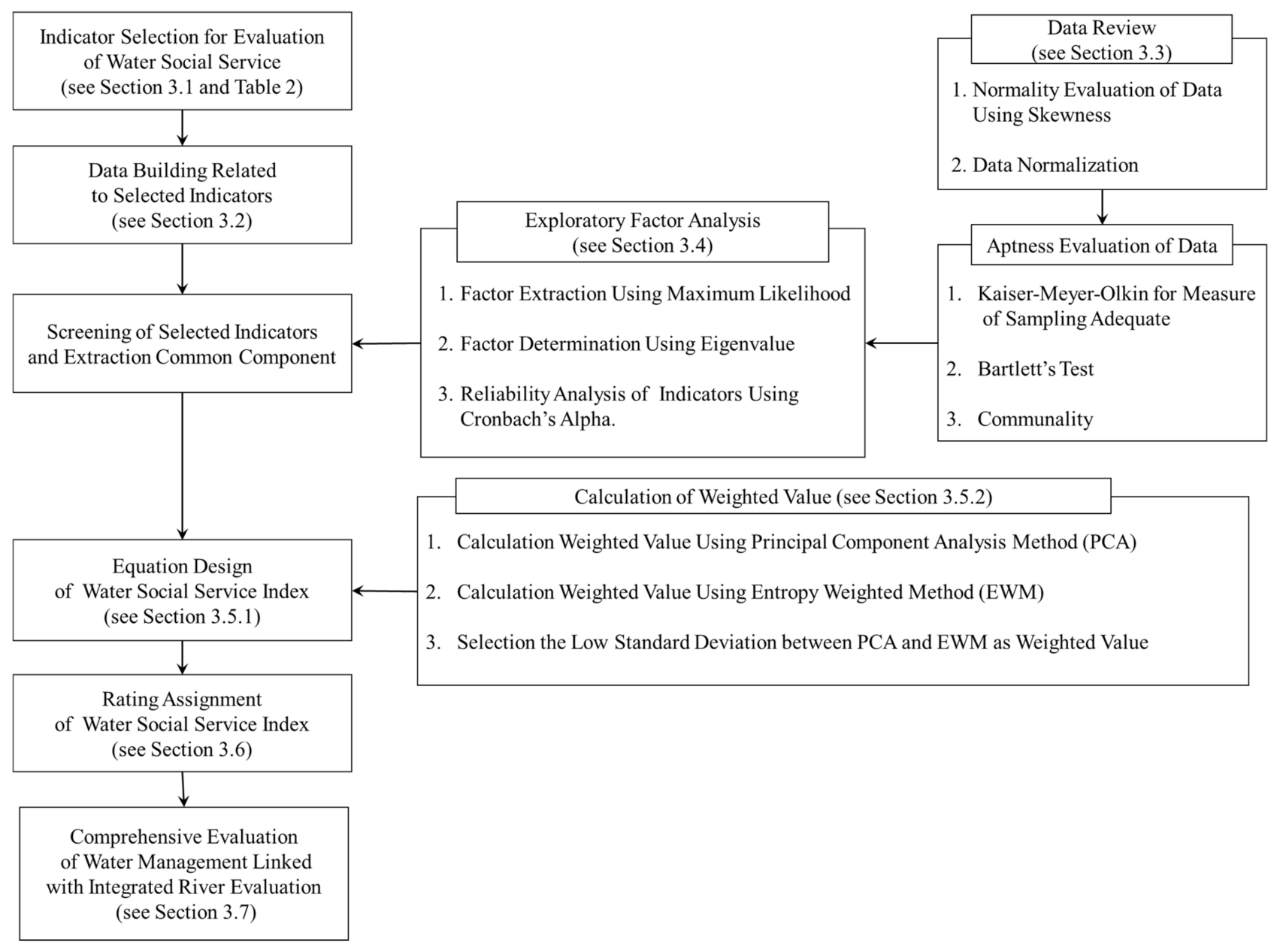

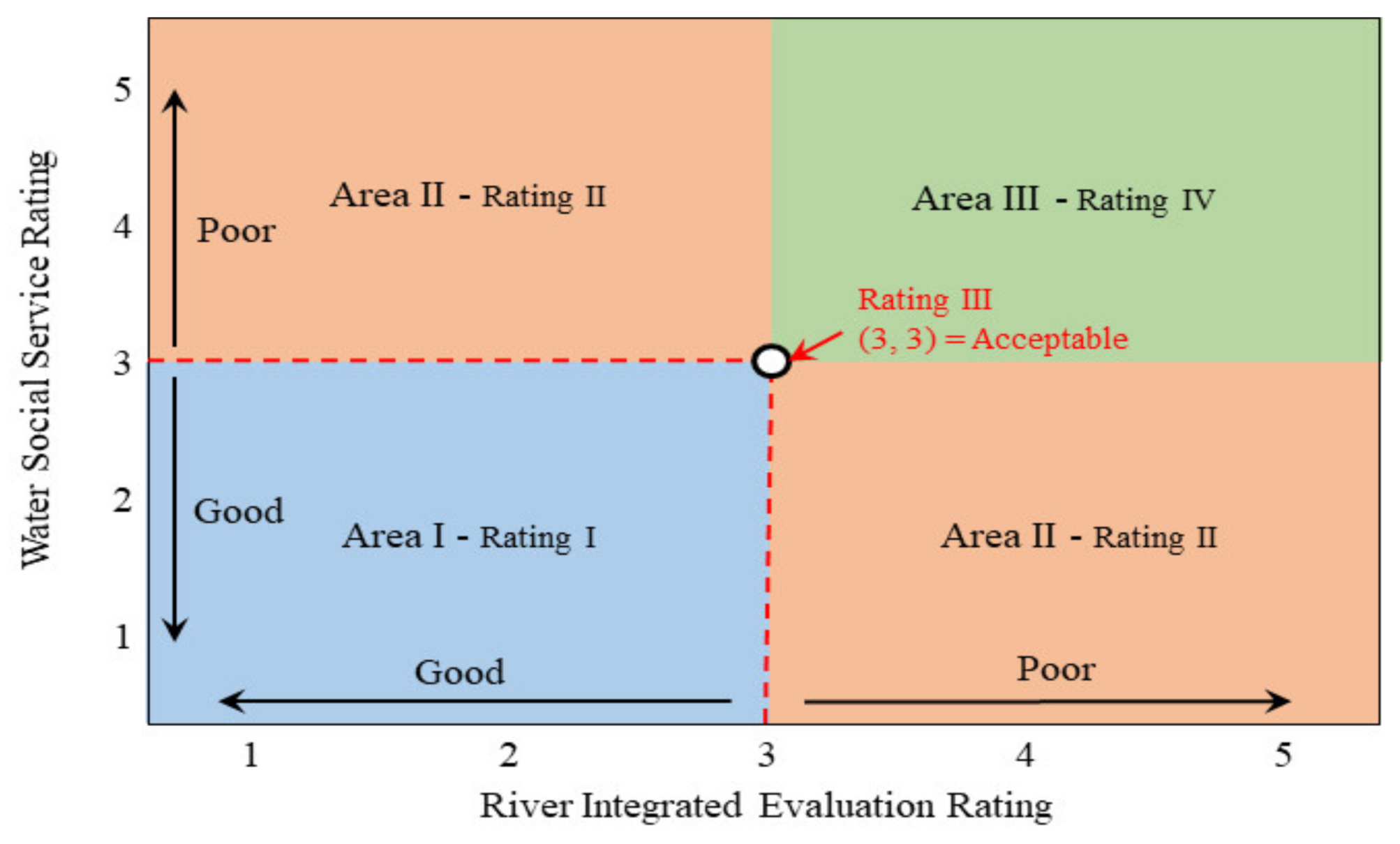
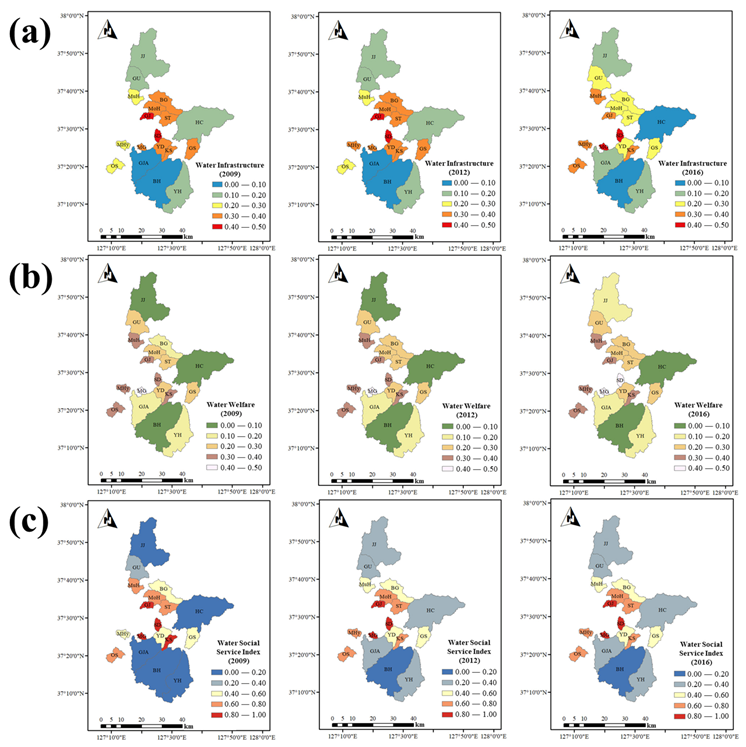
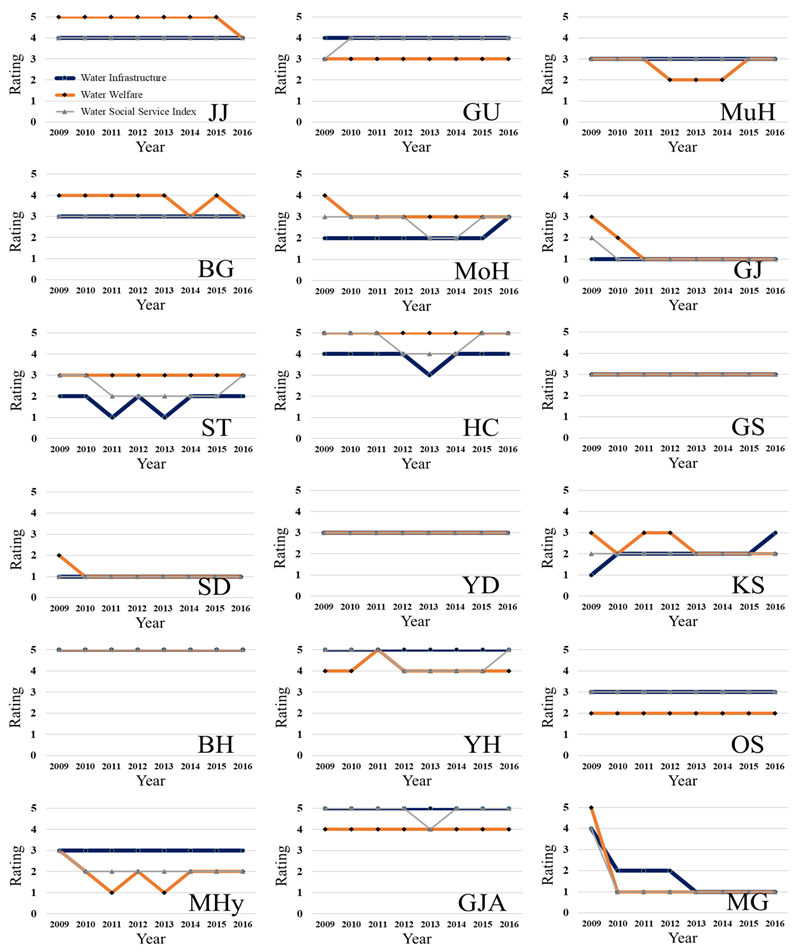
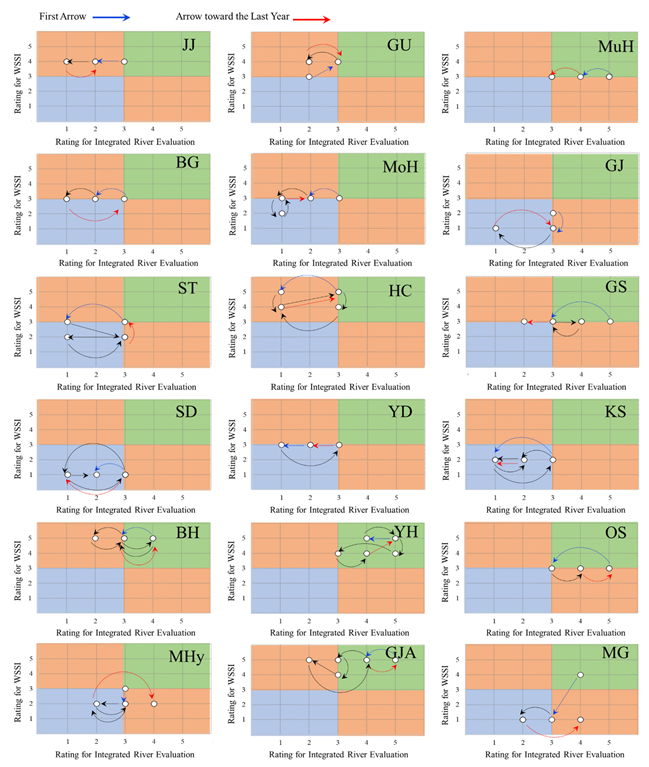
| No. | Watershed Name | Watershed Area (km2) | Abbreviation |
|---|---|---|---|
| 1 | JoJong | 260.3 | JJ |
| 2 | GuUn | 88.0 | GU |
| 3 | MukHyeon | 37.1 | MuH |
| 4 | ByeokGye | 78.0 | BG |
| 5 | MoonHo | 49.6 | MoH |
| 6 | GaJung | 18.6 | GJ |
| 7 | SaTan | 45.3 | ST |
| 8 | HeukCheon | 314.0 | HC |
| 9 | GokSu | 51.5 | GS |
| 10 | SungDuk | 17.3 | SD |
| 11 | YongDam | 47.9 | YD |
| 12 | KumSa | 23.8 | KS |
| 13 | BokHa | 309.1 | BH |
| 14 | YangHwa | 181.7 | YH |
| 15 | OSan | 34.8 | OS |
| 16 | MokHyeon | 20.4 | MHy |
| 17 | GonJiAm | 158.7 | GJA |
| 18 | MuGap | 10.5 | MG |
| Category | Indicators | Reason for Selection | Abbreviation |
|---|---|---|---|
| Water Supply Capacity | Revenue water ratio | Ratio of revenue water to total water quantity; it represents the transfer efficiency of water delivery/distribution or the actual supply ratio of water | RWR |
| Water supply amount | Amount of water supplied for each purpose or the total amount of supplied water; represented as the sum of industrial water and domestic water | WSA | |
| Water supply and demand ratio | Ratio of supply to demand of water, which identifies the regions having limitations in using water; it compares the usage amount to the available amount of supply | WSDR | |
| Water Usage | Daily water usage per person | Domestic water usage with respect to the population in the watershed; a high indicator value implies the overconsumption of domestic water | DWUP |
| Amount of replacement water | Represents the amount of potential water resources, which can replace rivers through recirculation of sewage and reclaimed water | ARW | |
| Supply ratio of water system | Ratio of the population supplied with water to the entire population; a high indicator value implies that water usage is adequate | SUWS | |
| Supply ratio of sewer treatment system | Ratio of the population receiving sewage service to the entire population; a high indicator value implies that the water usage is adequate | SRST | |
| Water Service Management | Cost recovery rate of water supply | Rate of water charge to the unit cost of water supply production;a high indicator value implies that the water service management is adequate | CRWS |
| Cost recovery rate of sewage service | Rate of sewage service charge to the cost of sewage treatment; a high indicator value implies that the water service management is adequate | CRSS | |
| Self-reliance ratio of water supply | Ratio of annual revenue to annual expenditure (construction + maintenance costs)/water charge; it represents the self-reliance of water supply service | SRWS | |
| Self-reliance ratio of sewage service | Ratio of annual revenue to annual expenditure (construction + maintenance costs)/water charge; it represents the self-reliance of sewage service | SRSS | |
| Water Service Equity | Water supply and demand ratio of the elderly population | Water supply and demand ratio per elder; it determines the vulnerability of water supply and demand in the elderly population | WREP |
| Water usage amount of the elderly population | Daily water usage amount per elder; it determines the vulnerability of water usage in the elderly population | WUEP | |
| Water supply and demand ratio of the beneficiaries of national basic livelihood | Water supply and demand ratio of the beneficiaries of national basic livelihood; it determines the vulnerability of water supply and demand of the socioeconomically disadvantaged population | WSDB | |
| Water usage amount of the beneficiaries of national basic livelihood | Daily water usage amount per beneficiary of national basic livelihood; it determines the vulnerability of water usage of socioeconomically disadvantaged population | WUSB |
| Rating Section | Rating | Key Processing Function | |
|---|---|---|---|
| μ + 1.0 σ | 100.0–84.0% | 1 | Very Good (High) |
| μ + 0.5 σ | 84.0–67.5% | 2 | Good (Medium High) |
| - | 67.5–32.5% | 3 | Acceptable (Medium) |
| μ − 0.5 σ | 32.5–16.0% | 4 | Poor (Medium Low) |
| μ − 1.0 σ | 16.0–0.0% | 5 | Very Poor (Low) |
| Indicator | (a) Skewness before Conversion | (b) Skewness after Conversion |
|---|---|---|
| Revenue water ratio (RWR) (%) | 1.708 | 0.226 |
| Water supply amount (WSA) (ton/year) | 1.985 | −0.008 |
| Water supply and demand ratio (WSDR) (%) | 1.161 | 0.292 |
| Daily water usage per person (DWUP) (ton/year) | 1.566 | 0.483 |
| Amount of replacement water (ARW) (ton/year) | 3.586 | −0.063 |
| Supply ratio of water system (SUWS) (%) | 1.768 | 0.204 |
| Supply ratio of sewer treatment system (SRST) (%) | 1.504 | 0.313 |
| Cost recovery rate of water supply (CRWS) (%) | 1.911 | 0.137 |
| Cost recovery rate of sewage service (CRSS) (%) | 2.536 | −0.302 |
| Self-reliance ratio of water supply (SRWS) | 2.670 | 0.278 |
| Self-reliance ratio of sewage service (SRSS) | 3.001 | 0.243 |
| Water supply and demand ratio of the elderly population (WREP) (%) | 1.821 | 0.262 |
| Water usage amount of the elderly population (WUEP) (ton/year) | 1.165 | 0.300 |
| Water supply and demand ratio of the beneficiaries of national basic livelihood (WSDB) | 2.016 | 0.236 |
| Water usage amount of the beneficiaries of national basic livelihood (WUSB) | 1.163 | 0.302 |
| Contents | Value | ||||
| KMO Measure | 0.879 | ||||
| Bartlett’s test of sphericity | Approx. Chi-squared | 7258.480 | |||
| p (significance probability) | <0.001 | ||||
| Communality | |||||
| No. | Indicators (abbreviation) | Extraction | Remark | ||
| 1 | Revenue water ratio (RWR) | 0.996 | - | ||
| 2 | Water supply amount (WSA) | 0.964 | - | ||
| 3 | Water supply and demand ratio (WSDR) | 0.997 | - | ||
| 4 | Daily water usage per person (DWUP) | 0.990 | - | ||
| 5 | Amount of replacement water (ARW) | 0.844 | - | ||
| 6 | Supply ratio of water system (SUWS) | 0.999 | - | ||
| 7 | Supply ratio of sewer treatment system (SRST) | 0.994 | - | ||
| 8 | Cost recovery rate of water supply (CRWS) | 0.996 | - | ||
| 9 | Cost recovery rate of sewage service (CRSS) | 0.911 | - | ||
| 10 | Self-reliance ratio of water supply (SRWS) | 0.973 | - | ||
| 11 | Self-reliance ratio of sewage service (SRSS) | 0.946 | - | ||
| 12 | Water supply and demand ratio of the elderly population (WREP) | 0.992 | - | ||
| 13 | Water usage amount of the elderly population (WUEP) | 1.000 | Heywood case (Removed) | ||
| 14 | Water supply and demand ratio of the beneficiaries of national basic livelihood (WSDB) | 0.986 | - | ||
| 15 | Water usage amount of the beneficiaries of national basic livelihood (WUSB) | 1.000 | Heywood case (Removed) | ||
| Contents | Value | |||
| KMO Measure | 0.851 | |||
| Bartlett’s test of sphericity | Approx. Chi-squared | 533.132 | ||
| p (significance probability) | <0.001 | |||
| Communality | ||||
| No. | Indicators (abbreviation) | Extraction | ||
| 1 | Cost recovery rate of water supply (CRWS) | 0.993 | ||
| 2 | Supply ratio of water system (SUWS) | 0.933 | ||
| 3 | Revenue water ratio (RWR) | 0.990 | ||
| 4 | Water supply amount (WSA) | 0.951 | ||
| 5 | Supply ratio of sewer treatment system (SRST) | 0.574 | ||
| 6 | Cost recovery rate of sewage service (CRSS) | 0.998 | ||
| 7 | Amount of replacement water (ARW) | 0.985 | ||
| 8 | Water supply and demand ratio of the elderly population (WREP) | 0.987 | ||
| 9 | Water supply and demand ratio of the beneficiaries of national basic livelihood (WSDB) | 0.764 | ||
| 10 | Self-reliance ratio of water supply (SRWS) | 0.871 | ||
| 11 | Daily water usage per person (DWUP) | 0.736 | ||
| 12 | Water supply and demand ratio (WSDR) | 0.990 | ||
| 13 | Self-reliance ratio of sewage service (SRSS) | 0.977 | ||
| Factor | Initial Eigenvalues | Extraction Sums of Squared Loadings | Rotation Sums of Squared Loadings | ||||
|---|---|---|---|---|---|---|---|
| Total | % of Variance | Cumulative % | Total | % of Variance | Cumulative % | Total | |
| 1 | 10.500 | 80.770 | 80.770 | 10.334 | 79.494 | 79.494 | 9.026 |
| 2 | 1.606 | 12.351 | 93.121 | 1.416 | 10.892 | 90.386 | 8.309 |
| 3 | 0.377 | 2.899 | 96.020 | - | - | - | - |
| 4 | 0.215 | 1.655 | 97.674 | - | - | - | - |
| 5 | 0.172 | 1.320 | 98.995 | - | - | - | - |
| 6 | 0.038 | 0.295 | 99.290 | - | - | - | - |
| 7 | 0.033 | 0.256 | 99.546 | - | - | - | - |
| 8 | 0.027 | 0.205 | 99.752 | - | - | - | - |
| 9 | 0.014 | 0.110 | 99.861 | - | - | - | |
| 10 | 0.008 | 0.064 | 99.925 | - | - | - | - |
| 11 | 0.005 | 0.036 | 99.962 | - | - | - | - |
| 12 | 0.004 | 0.032 | 99.993 | - | - | - | - |
| 13 | 0.001 | 0.007 | 100.000 | - | - | - | - |
| No. | Indicators (Abbreviation) | Pattern Matrix | Structure Matrix | Cronbach’s Alpha if Item Delete | Cronbach’s Alpha | |||
|---|---|---|---|---|---|---|---|---|
| Factor 1 | Factor 2 | Factor 1 | Factor 2 | |||||
| 1 | Cost recovery rate of water supply (CRWS) | 0.985 | −0.032 | 0.991 | 0.671 | 0.969 | 0.978 | |
| 2 | Supply ratio of water system (SUWS) | 0.936 | 0.089 | 0.978 | 0.767 | 0.970 | ||
| 3 | Revenue water ratio (RWR) | 0.862 | −0.192 | 0.968 | 0.788 | 0.970 | ||
| 4 | Water supply amount (WSA) | 0.837 | 0.058 | 0.965 | 0.581 | 0.972 | ||
| 5 | Supply ratio of sewer treatment system (SRST) | 0.816 | 0.260 | 0.941 | 0.832 | 0.972 | ||
| 6 | Cost recovery rate of sewage service (CRSS) | 0.779 | 0.303 | 0.873 | 0.578 | 0.977 | ||
| 7 | Amount of replacement water (ARW) | 0.691 | 0.403 | 0.743 | 0.344 | 0.978 | ||
| 8 | Water supply and demand ratio of the elderly population (WREP) | −0.008 | 0.993 | 0.636 | 0.995 | 0.969 | 0.979 | |
| 9 | Water supply and demand ratio of the beneficiaries of national basic livelihood (WSDB) | 0.028 | 0.978 | 0.610 | 0.989 | 0.969 | ||
| 10 | Self-reliance ratio of water supply (SRWS) | −0.088 | 0.910 | 0.710 | 0.916 | 0.970 | ||
| 11 | Daily water usage per person (DWUP) | 0.230 | 0.773 | 0.842 | 0.909 | 0.970 | ||
| 12 | Water supply and demand ratio (WSDR) | 0.450 | 0.630 | 0.796 | 0.896 | 0.974 | ||
| 13 | Self-reliance ratio of sewage service (SRSS) | 0.552 | 0.653 | 0.478 | 0.855 | 0.979 | ||
| Goodness of fit test | Chi-squared | 765.973 | ||||||
| p | <0.001 | |||||||
| Total Cronbach’s alpha | 0.980 | |||||||
| No. | Factors | Indicators | Symbol of Weighted Value | Weighted Value | |
|---|---|---|---|---|---|
| Principal Component Analysis Methods | Entropy Weighted Method | ||||
| 1 | Water Infrastructure | Cost recovery rate of water supply (CRWS) | W1 | 0.0879 | 0.0807 |
| 2 | Supply ratio of water system (SRWS SUWS) | W2 | 0.0856 | 0.0881 | |
| 3 | Revenue water ratio (RWR) | W3 | 0.0839 | 0.0859 | |
| 4 | Water supply amount (WSA) | W4 | 0.0833 | 0.0908 | |
| 5 | Supply ratio of sewer treatment system (SRST) | W5 | 0.0792 | 0.0857 | |
| 6 | Cost recovery rate of sewage service (CRSS) | W6 | 0.0682 | 0.0764 | |
| 7 | Amount of replacement water (ARW) | W7 | 0.0494 | 0.0701 | |
| 8 | Water Welfare | Water supply and demand ratio of the elderly population (WREP) | W8 | 0.0886 | 0.0668 |
| 9 | Water supply and demand ratio of the beneficiaries of national basic livelihood (WSDB) | W9 | 0.0875 | 0.0630 | |
| 10 | Self-reliance ratio of water supply (SRWS) | W10 | 0.0751 | 0.0475 | |
| 11 | Daily water usage per person (DWUP) | W11 | 0.0739 | 0.0946 | |
| 12 | Water supply and demand ratio (WSDR) | W12 | 0.0718 | 0.0922 | |
| 13 | Self-reliance ratio of sewage service (SRSS) | W13 | 0.0654 | 0.0564 | |
| Sum | 1.0000 | 1.0000 | |||
| Standard Deviation | 0.0113 | 0.0150 | |||
| Study Watershed | Water Infrastructure (WI) | Water Welfare (WW) | Water Social Service Index (WSSI) | |||
|---|---|---|---|---|---|---|
| Value | Rank | Value | Rank | Value | Rank | |
| JJ | 0.1609 | 13 | 0.0922 | 17 | 0.2531 | 14 |
| GU | 0.1393 | 15 | 0.2375 | 12 | 0.3768 | 13 |
| MuH | 0.2374 | 12 | 0.3333 | 7 | 0.5707 | 11 |
| BG | 0.3078 | 10 | 0.2195 | 13 | 0.5273 | 12 |
| MoH | 0.3724 | 6 | 0.2728 | 9 | 0.6452 | 7 |
| GJ | 0.4856 | 2 | 0.3790 | 3 | 0.8646 | 2 |
| ST | 0.3822 | 4 | 0.2821 | 8 | 0.6643 | 6 |
| HC | 0.1572 | 14 | 0.0713 | 17 | 0.2285 | 16 |
| GS | 0.3118 | 8 | 0.2592 | 11 | 0.5710 | 10 |
| SD | 0.4944 | 1 | 0.3872 | 2 | 0.8816 | 1 |
| YD | 0.3092 | 9 | 0.2653 | 10 | 0.5745 | 9 |
| KS | 0.3749 | 5 | 0.3391 | 6 | 0.7160 | 4 |
| BH | 0.0266 | 18 | 0.1761 | 14 | 0.1027 | 18 |
| YH | 0.1155 | 16 | 0.1223 | 16 | 0.2378 | 15 |
| OS | 0.2574 | 11 | 0.3556 | 5 | 0.6130 | 8 |
| MHy | 0.3142 | 7 | 0.3569 | 4 | 0.6711 | 5 |
| GJA | 0.0852 | 17 | 0.1385 | 15 | 0.2237 | 17 |
| MG | 0.4008 | 3 | 0.4341 | 1 | 0.8349 | 3 |
| Average | 0.2740 | – | 0.2623 | – | 0.5309 | – |
| Median | 0.3085 | – | 0.2691 | – | 0.5728 | – |
| Study Watershed | Rating | ||
|---|---|---|---|
| Water Infrastructure | Water Welfare | Water Social Service Index | |
| JJ | 4 | 5 | 4 |
| GU | 4 | 3 | 4 |
| MuH | 3 | 3 | 3 |
| BG | 3 | 4 | 3 |
| MoH | 2 | 3 | 3 |
| GJ | 1 | 1 | 1 |
| ST | 2 | 3 | 2 |
| HC | 4 | 5 | 5 |
| GS | 3 | 3 | 3 |
| SD | 1 | 1 | 1 |
| YD | 3 | 3 | 3 |
| KS | 2 | 2 | 2 |
| BH | 5 | 5 | 5 |
| YH | 5 | 4 | 5 |
| OS | 3 | 2 | 3 |
| MHy | 3 | 2 | 2 |
| GJA | 5 | 4 | 5 |
| MG | 2 | 2 | 1 |
Publisher’s Note: MDPI stays neutral with regard to jurisdictional claims in published maps and institutional affiliations. |
© 2021 by the authors. Licensee MDPI, Basel, Switzerland. This article is an open access article distributed under the terms and conditions of the Creative Commons Attribution (CC BY) license (http://creativecommons.org/licenses/by/4.0/).
Share and Cite
Kim, D.Y.; Park, S.H.; Song, C.M. Evaluation of Water Social Service and Comprehensive Water Management Linked with Integrated River Evaluation. Water 2021, 13, 706. https://doi.org/10.3390/w13050706
Kim DY, Park SH, Song CM. Evaluation of Water Social Service and Comprehensive Water Management Linked with Integrated River Evaluation. Water. 2021; 13(5):706. https://doi.org/10.3390/w13050706
Chicago/Turabian StyleKim, Da Ye, Su Hee Park, and Chul Min Song. 2021. "Evaluation of Water Social Service and Comprehensive Water Management Linked with Integrated River Evaluation" Water 13, no. 5: 706. https://doi.org/10.3390/w13050706
APA StyleKim, D. Y., Park, S. H., & Song, C. M. (2021). Evaluation of Water Social Service and Comprehensive Water Management Linked with Integrated River Evaluation. Water, 13(5), 706. https://doi.org/10.3390/w13050706






